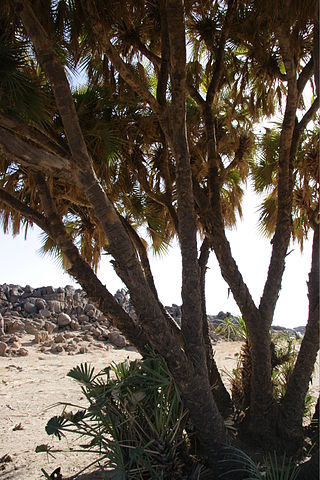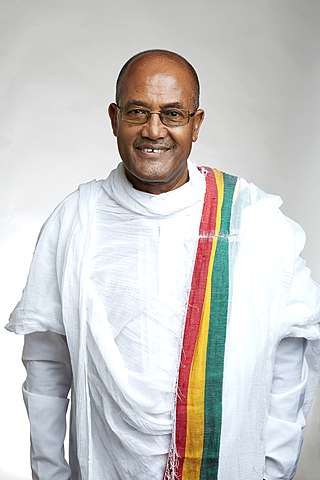Related Research Articles

Hyphaene is a genus of palms native to Africa, Madagascar, the Middle East, and the Indian subcontinent.
Dypsis canescens, also known as Chrysalidocarpus canescens, is a species of flowering plant in the family Arecaceae. It is endemic to the Sambirano region of northwestern Madagascar. It was identified in 1913. It is probably extinct, given that it has not been seen for half a century.

Dypsis decipiens, the Manambe palm, is a species of flowering plant in the Palm family (Arecaceae). It is found only in the central highlands of Madagascar, between Fianarantsoa and Andilamena at 1,200 to 1,700 meters elevation. The species is threatened by habitat loss, increasing frequency of fires, and over-exploitation of its seeds for the horticultural trade. Its most unique characteristic is that it commonly produces twin trunks like the letter "V", each trunk being up to 65 feet in height and up to 28 inches DBH. There can also be three trunks, or a single trunk.
Dypsis onilahensis is a species of palm tree in the family Arecaceae. It is endemic to Madagascar as is reflected in the species name (onilahensis) referring to the Onilahy River, south of Toliara. It is threatened by habitat loss.
Dypsis singularis is a species of flowering plant in the Palm Family. It is found only on the island of Madagascar. It is threatened by habitat loss. It is remarkable for its height to width ratio; the greatest of any tree. It is up to 19ft 8in tall while being only 2/5ths of a inch in diameter, a length/width ratio of 600 fold.
Masoala kona is a species of flowering plant in the Palm Family. It is a palm endemic to Madagascar, where it grows in rainforests. There are fewer than 60 individuals estimated to remain. Its most remarkable feature is that its leaves bear the longest "segments" of any plant; up to 8.2 feet in length. A leaf segment has a broad attachment to the rachis rather than a petiolule. It differs from a lobed leaf in that the lamina (leaf) is not continuous. The species is threatened by habitat loss.
Masoala is a genus of flowering plant in the family Arecaceae. It contains the following species, both endemic to Madagascar:

Orania ravaka is a species of flowering plant in the family Arecaceae.
Ravenea musicalis, or the river palm, is a species of flowering plant in the family Arecaceae. Also known by the Antanosy word "torendriky," meaning "submerged trunk", R. musicalis is known for being the only truly aquatic palm tree. Like many mangrove trees, R. musicalis seeds germinate within the fruit, and the seedling takes root underwater. as much as eight feet below the surface. Endemic to Madagascar, R. musicalis was first discovered in 1993 by Henk Beentje on an expedition funded by the McDonald's restaurant. This palm is listed in the IUCN Red List. This tree is harvested by local people primarily for building material and food. Over-harvesting, habitat degradation and habitat loss threaten the remaining populations. Horticulturalists prize R. musicalis for its rarity and unique life history.

Satranala decussilvae is a species of flowering plant in the Arecaceae family. It is a palm endemic to Madagascar. It is the only species in the genus Satranala, and is threatened by habitat loss. There are perhaps 200 mature individuals remaining.

Bernard Verdcourt was a biologist and taxonomist, most widely known as a botanist and latterly an honorary research fellow at the Royal Botanic Gardens, Kew in London. Prior to coming to Kew in 1964, he was associated with the East African Herbarium for 15 years. Although his best-known work probably consists of his many studies of the East African flora, he has also made extensive contributions relating to African terrestrial mollusks and to entomology. Dr. Verdcourt received the Linnean Medal for botany from the Linnean Society of London in 2000. His list of publications includes more than 1,000 scientific works. The standard author abbreviation Verdc. is used to indicate this person as the author when citing a botanical name.

Kerriodoxa elegans, the white backed palm, is the only species of palm tree in the genus Kerriodoxa, in the family Arecaceae.
Prof. Karl Olov Hedberg of Västerås was a botanist, taxonomist, author, professor of systematic botany at Uppsala University from 1970 to 1989, and an Editor of the Flora of Ethiopia.
Leslie Desmond Edward Foster-Vesey-Fitzgerald MBE, was an Irish-born entomologist, ornithologist, conservationist, and plant collector.
Dypsis brevicaulis is a species of flowering plant in the Arecaceae family. It is a dwarf palm found on only three sites in Madagascar, with fewer than fifty plants ever found in the wild. The plant is part of the IUCN Sampled Red List Index for Plants, a study of representative species from all over the world which is studying extinction trends for plants.
John Dransfield is an honorary research fellow and former head of palm research at the Royal Botanic Gardens, Kew, United Kingdom, as well as being an authority on the phylogenetic classification of palms.

Borasseae is a tribe in the palm subfamily Coryphoideae. The tribe ranges from southern Africa and Madagascar north through the Arabian Peninsula to India, Indochina, Indonesia and New Guinea. Several genera are restricted to islands in the Indian Ocean. The two largest genera, Hyphaene and Borassus, are also the most widespread.

Chuniophoeniceae is a tribe of palms in subfamily Coryphoideae of plant family Arecaceae. The four genera within the tribe are morphologically dissimilar and do not have overlapping distributions. Three of the genera are monotypic, while the fourth genus (Chuniophoenix) has three species.

Sebsebe Demissew is a Professor of Plant Systematics and Biodiversity at Addis Ababa University and Executive Director of the Gullele Botanic Garden in Addis Ababa, Ethiopia.
Soejatmi Dransfield is an Indonesia-born British plant taxonomist specializing in bamboos and currently honorary research fellow at the Royal Botanic Gardens, Kew, UK.